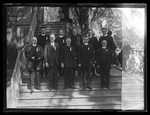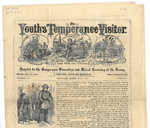Keywords: Fire prevention
- Historical Items (123)
- Tax Records (0)
- Architecture & Landscape (1)
- Online Exhibits (26)
- Site Pages (15)
- My Maine Stories (2)
- Lesson Plans (0)
Online Exhibits
Your results include these online exhibits. You also can view all of the site's exhibits, view a timeline of selected events in Maine History, and learn how to create your own exhibit. See featured exhibits or create your own exhibit
Exhibit
Looking Out: Maine's Fire Towers
Maine, the most heavily forested state in the nation, had the first continuously operational fire lookout tower, beginning a system of fire prevention that lasted much of the twentieth century.
Exhibit
Navy Firefighting School, Little Chebeague Island
Little Chebeague Island in Casco Bay was home to recreational facilities and a firefighting school for WWII sailors. The school was part of a Navy effort to have non-firefighting personnel knowledgeable in dealing with shipboard fires.
Exhibit
Throughout the history of the state, residents have protested, on paper or in the streets, to increase rights for various groups, to effect social change, to prevent social change, or to let their feelings be known about important issues.
Exhibit
Rum, Riot, and Reform - Reform and Repeal
"… handbill encourages citizens in Waterville to prevent liquor being sold in their town. Maine towns voted on this issue every two years."
Exhibit
Rum, Riot, and Reform - Temperance Membership
"… 3-48 One of numerous publications aimed at preventing a younger generation from taking up the habit."
Exhibit
Rum, Riot, and Reform - 1919 to 1934: The Nation Follows Maine Into Prohibition
"… were exerting themselves to the utmost to prevent the sale of liquor." GALLERIES: Bootleggers vs."
Exhibit
Rum, Riot, and Reform - Society Copes
"… through the mail, gives specific instructions to prevent fermentation. So specific that the method of turning the juice into wine is very clear."
Exhibit
Public education has been a part of Maine since Euro-American settlement began to stabilize in the early eighteenth century. But not until the end of the nineteenth century was public education really compulsory in Maine.
Exhibit
Putting Men to Work, Saving Trees
While many Mainers were averse to accepting federal relief money during the Great Depression of the 1930s, young men eagerly joined the Civilian Conservation Corps, one of President Franklin Roosevelt's most popular programs. The Maine Forest Service supervised the work of many of the camps.
Exhibit
Fallen Heroes: Jewish Soldiers and Sailors, The Great War
Thirty-four young Jewish men from Maine died in the service of their country in the two World Wars. This project, including a Maine Memory Network exhibit, is meant to say a little something about some of them. More than just names on a public memorial marker or grave stone, these men were getting started in adult life. They had newly acquired high school and college diplomas, they had friends, families and communities who loved and valued them, and felt the losses of their deaths.
Exhibit
CODE RED: Climate, Justice & Natural History Collections
Explore topics around climate change by reuniting collections from one of the nation's earliest natural history museums, the Portland Society of Natural History. The exhibition focuses on how museums collect, and the role of humans in creating changes in society, climate, and biodiversity.
Exhibit
From French Canadians to Franco-Americans
French Canadians who emigrated to the Lewiston-Auburn area faced discrimination as children and adults -- such as living in "Little Canada" tenements and being ridiculed for speaking French -- but also adapted to their new lives and sustained many cultural traditions.
Exhibit
Mainers have been held prisoners in conflicts fought on Maine and American soil and in those fought overseas. In addition, enemy prisoners from several wars have been brought to Maine soil for the duration of the war.
Exhibit
Hiking, Art and Science: Portland's White Mountain Club
In 1873, a group of men, mostly from Portland, formed the second known hiking club in the U.S., the White Mountain Club of Portland, to carry out their scientific interests, their love of hiking and camaraderie, and their artistic interests in painting and drawing the features of several of the White Mountains.
Exhibit
Field & Homefront: Bethel during the Civil War
Like many towns, Bethel responded to the Civil War by sending many soldiers and those at the homefront sent aid and supported families. The town grew during the war, but suffered after its end.
Exhibit
Wired! How Electricity Came to Maine
As early as 1633, entrepreneurs along the Piscataqua River in southern Maine utilized the force of the river to power a sawmill, recognizing the potential of the area's natural power sources, but it was not until the 1890s that technology made widespread electricity a reality -- and even then, consumers had to be urged to use it.
Exhibit
Sagadahoc County through the Eastern Eye
The Eastern Illustrating and Publishing Company of Belfast, Maine. employed photographers who traveled by company vehicle through New England each summer, taking pictures of towns and cities, vacation spots and tourist attractions, working waterfronts and local industries, and other subjects postcard recipients might enjoy. The cards were printed by the millions in Belfast into the 1940s.
Exhibit
War Through the Eyes of a Young Sailor
Eager to deal with the "Sesech" [Secessionists], young deepwater sailor John Monroe Dillingham of Freeport enlisted in the U.S. Navy as soon as he returned from a long voyage in 1862. His letters and those of his family offer first-hand insight into how one individual viewed the war.
Exhibit
This Rebellion: Maine and the Civil War
For Mainers like many other people in both the North and the South, the Civil War, which lasted from 1861-1865, had a profound effect on their lives. Letters, artifacts, relics, and other items saved by participants at home and on the battlefield help illuminate the nature of the Civil War experience for Mainers.
Exhibit
In Time and Eternity: Shakers in the Industrial Age
"In Time and Eternity: Maine Shakers in the Industrial Age 1872-1918" is a series of images that depict in detail the Shakers in Maine during a little explored time period of expansion and change.
Exhibit
One Hundred Years of Caring -- EMMC
In 1892 five physicians -- William H. Simmons, William C. Mason, Walter H. Hunt, Everett T. Nealey, and William E. Baxter -- realized the need for a hospital in the city of Bangor had become urgent and they set about providing one.
Exhibit
From Sewers to Skylines: William S. Edwards's 1887 Photo Album
William S. Edwards (1830-1918) was a civil engineer who worked for the City of Portland from 1876-1906. Serving as First Assistant to Chief Engineer William A. Goodwin, then to Commissioner George N. Fernald, Edwards was a fixture in City Hall for 30 consecutive years, proving indispensable throughout the terms of 15 Mayors of Portland, including all six of those held by James Phineas Baxter. Edwards made significant contributions to Portland, was an outstanding mapmaker and planner, and his works continue to benefit historians.
Exhibit
For one hundred years, Acadia National Park has captured the American imagination and stood as the most recognizable symbol of Maine’s important natural history and identity. This exhibit highlights Maine Memory content relating to Acadia and Mount Desert Island.
Exhibit
Maine Eats: the food revolution starts here
From Maine's iconic lobsters, blueberries, potatoes, apples, and maple syrup, to local favorites like poutine, baked beans, red hot dogs, Italian sandwiches, and Whoopie Pies, Maine's identity and economy are inextricably linked to food. Sourcing food, preparing food, and eating food are all part of the heartbeat of Maine's culture and economy. Now, a food revolution is taking us back to our roots in Maine: to the traditional sources, preparation, and pleasures of eating food that have sustained Mainers for millennia.
























